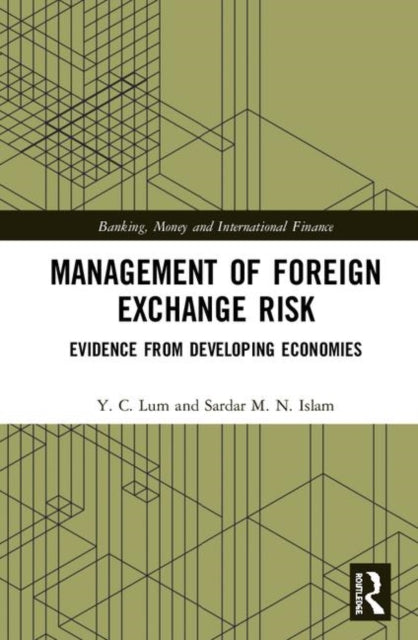Y. C. Lum,Sardar M. N.Islam
Management of Foreign Exchange Risk: Evidence from Developing Economies
Management of Foreign Exchange Risk: Evidence from Developing Economies
YOU SAVE £6.96
- Condition: Brand new
- UK Delivery times: Usually arrives within 2 - 3 working days
- UK Shipping: Fee starts at £2.39. Subject to product weight & dimension
Bulk ordering. Want 15 or more copies? Get a personalised quote and bigger discounts. Learn more about bulk orders.
Couldn't load pickup availability
- More about Management of Foreign Exchange Risk: Evidence from Developing Economies
This book discusses the issues of risk management and theory and hypothesis development in foreign exchange and financial markets, with a focus on the volatility of exchange rates. It applies an integrated study of exchange rate volatility in Malaysia, a case study of a developing country, and develops advanced econometric models for risk management strategies. It is a valuable resource for fund managers, financial market analysts, researchers, academics, practitioners, policy makers, and postgraduate students in finance, accounting, business, and financial economics.
\n Format: Hardback
\n Length: 268 pages
\n Publication date: 03 September 2020
\n Publisher: Taylor & Francis Ltd
\n
This comprehensive book delves into the intricate world of contemporary and emerging issues in foreign exchange and financial markets, offering a technical and specialized exploration. By addressing the critical concerns of risk management and theory and hypothesis development, it extends its reach to encompass the broader realm of finance theory and foreign exchange market management. With an in-depth and comprehensive analysis, the book sheds light on the complex dynamics of exchange rate volatility, a topic of paramount importance in today's global financial landscape.
The book's three primary objectives are as follows:
Firstly, it employs an integrated approach to studying exchange rate volatility, encompassing both depth and breadth. This comprehensive examination allows for a thorough exploration of the various factors contributing to this volatility, providing valuable insights into its underlying mechanisms.
Secondly, the book takes a case study approach, focusing on Malaysia as a developing country. Malaysia has a history of implementing capital control measures and has recently liberalized its exchange rate market, indicating a commitment to further liberalization in the long term. Understanding exchange rate volatility measurement and management becomes increasingly crucial in such contexts, as it plays a pivotal role in shaping economic policies and strategies.
Thirdly, the book highlights new conditional volatility models tailored for developing countries like Malaysia. By developing advanced econometric models, it offers valuable tools for risk management strategies and achieving risk management in the financial market and the economy. Furthermore, the authors propose risk management themes that can have significant implications for other developing countries, contributing to the global discourse on financial stability and risk management.
This work serves as a valuable reference book for a wide range of professionals, including fund managers, financial market analysts, researchers, academics, practitioners, policy makers, and postgraduate students. Its comprehensive coverage and insightful analysis make it an essential resource for those seeking to deepen their understanding of finance, accounting, business, and financial economics. Additionally, it can serve as a supplementary text for Ph.D. and Masters students in these fields, enhancing their academic knowledge and expertise.
In conclusion, this book is a groundbreaking contribution to the field of finance and financial economics, providing a comprehensive and insightful exploration of contemporary and emerging issues in foreign exchange and financial markets. By addressing the critical concerns of risk management and theory and hypothesis development, it offers valuable insights into the complex dynamics of exchange rate volatility and its implications for global financial stability. As a reference book and supplementary text, it caters to a diverse audience, empowering professionals and students alike to navigate the complexities of the financial world and contribute to the betterment of the global economy.
\n Weight: 638g\n
Dimension: 162 x 240 x 25 (mm)\n
ISBN-13: 9780367418571\n \n
This item can be found in:
UK and International shipping information
UK and International shipping information
UK Delivery and returns information:
- Delivery within 2 - 3 days when ordering in the UK.
- Shipping fee for UK customers from £2.39. Fully tracked shipping service available.
- Returns policy: Return within 30 days of receipt for full refund.
International deliveries:
Shulph Ink now ships to Australia, Belgium, Canada, France, Germany, Ireland, Italy, India, Luxembourg Saudi Arabia, Singapore, Spain, Netherlands, New Zealand, United Arab Emirates, United States of America.
- Delivery times: within 5 - 10 days for international orders.
- Shipping fee: charges vary for overseas orders. Only tracked services are available for most international orders. Some countries have untracked shipping options.
- Customs charges: If ordering to addresses outside the United Kingdom, you may or may not incur additional customs and duties fees during local delivery.


